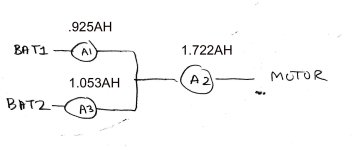Hi
I have an electric moped with a 20s 15Ah base battery pack with a BMS, for long journeys I want to add extra packs to the bike there are several compartments in the bike that extra battery's could be put. I'm wondering what would be the best way to connect the packs together if at all, all packs woulhave their own BMS a simple way to do it is to drain one pack then connect the next but that is messy and a cop out would connecting them in parallel cause any problems I would make sure the voltages were the same prior to connecting.
Need advise before I blow up several hundred pounds of liposuction
Geoff
I have an electric moped with a 20s 15Ah base battery pack with a BMS, for long journeys I want to add extra packs to the bike there are several compartments in the bike that extra battery's could be put. I'm wondering what would be the best way to connect the packs together if at all, all packs woulhave their own BMS a simple way to do it is to drain one pack then connect the next but that is messy and a cop out would connecting them in parallel cause any problems I would make sure the voltages were the same prior to connecting.
Need advise before I blow up several hundred pounds of liposuction
Geoff



